 Backend Development
Backend Development PHP Tutorial
PHP Tutorial What are SPL interfaces (e.g., Iterator, Countable, ArrayAccess) and why use them?
What are SPL interfaces (e.g., Iterator, Countable, ArrayAccess) and why use them?The SPL interface includes Iterator, Countable and ArrayAccess in PHP. 1. The Iterator interface makes the object traversable and defines the current(), key(), next(), rewind() and valid() methods. 2. The Countable interface allows the object to report the number of elements and defines the count() method. 3. The ArrayAccess interface allows objects to be accessed and modified like arrays, and defines offsetExists(), offsetGet(), offsetSet() and offsetUnset() methods. These interfaces improve code efficiency and maintainability.

introduction
The SPL (Standard PHP Library) interface is a powerful set of tools in PHP programming, which provide developers with standardized ways to handle data structures and object behavior. Today we are going to discuss Iterator, Countable and ArrayAccess in the SPL interface. Through this article, you will understand the definitions, working principles, and their application scenarios and advantages in actual development. Whether you are a beginner or an experienced developer, mastering these interfaces will greatly improve your code quality and maintainability.
Review of basic knowledge
In PHP, an interface is a blueprint that defines a specific method that a class must implement. The SPL interface is part of the PHP standard library and is designed to provide standardized implementations of common data structures and operations. Let's quickly review the basic concepts related to these interfaces:
- Objects and classes : Objects in PHP are instances of classes, and classes define the properties and methods of objects.
- Interface : An interface defines the signature of a set of methods, and any class that implements the interface must implement these methods.
- Iterator : Iterator is a design pattern that allows you to iterate over elements in a collection without exposing the underlying implementation.
Core concept or function analysis
Iterator interface
Definition and function : The Iterator interface allows objects to achieve traversability, allowing you to use a foreach loop to traverse elements in the object. It defines the following methods:
interface Iterator extends Traversable {
public function current();
public function key();
public function next();
public function rewind();
public function valid();
}How it works : When you use foreach to loop through an object that implements the Iterator interface, PHP will automatically call these methods to manage the traversal process. The rewind() method resets the pointer to the beginning of the collection, the next() method moves the pointer to the next element, the current() method returns the value of the current element, the key() method returns the key of the current element, and the valid() method checks whether the current position is valid.
Example :
class MyIterator implements Iterator {
private $position = 0;
private $array = ['a', 'b', 'c'];
public function __construct() {
$this->position = 0;
}
public function rewind() {
$this->position = 0;
}
public function current() {
return $this->array[$this->position];
}
public function key() {
return $this->position;
}
public function next() {
$this->position;
}
public function valid() {
return issue($this->array[$this->position]);
}
}
$it = new MyIterator();
foreach($it as $key => $value) {
echo "$key: $value\n";
}Countable interface
Definition and Function : The Countable interface allows an object to report the number of elements it contains. It defines a method:
interface Countable {
public function count();
}How it works : When you use the count() function on an object that implements the Countable interface, PHP will call the count() method of the object to get the number of elements.
Example :
class MyCountable implements Countable {
private $array = ['a', 'b', 'c'];
public function count() {
return count($this->array);
}
}
$countable = new MyCountable();
echo count($countable); // Output 3ArrayAccess interface
Definition and function : The ArrayAccess interface allows objects to be accessed and modified like arrays. It defines the following methods:
interface ArrayAccess {
public function offsetExists($offset);
public function offsetGet($offset);
public function offsetSet($offset, $value);
public function offsetUnset($offset);
}How it works : Objects that implement the ArrayAccess interface can use square bracket syntax to access and modify their internal data. offsetExists() method checks whether an offset exists, offsetGet() method gets the value of an offset, offsetSet() method sets the value of an offset, and offsetUnset() method deletes an offset.
Example :
class MyArrayAccess implements ArrayAccess {
private $container = [];
public function offsetExists($offset) {
return isset($this->container[$offset]);
}
public function offsetGet($offset) {
return $this->container[$offset] ?? null;
}
public function offsetSet($offset, $value) {
if (is_null($offset)) {
$this->container[] = $value;
} else {
$this->container[$offset] = $value;
}
}
public function offsetUnset($offset) {
unset($this->container[$offset]);
}
}
$arrayAccess = new MyArrayAccess();
$arrayAccess['key'] = 'value';
echo $arrayAccess['key']; // Output valueExample of usage
Basic usage
Iterator : Using the Iterator interface, you can easily iterate over custom objects. For example, suppose you have a custom collection class that you can implement the Iterator interface to make it traversable.
class MyCollection implements Iterator {
private $items = [];
private $position = 0;
public function add($item) {
$this->items[] = $item;
}
public function rewind() {
$this->position = 0;
}
public function current() {
return $this->items[$this->position];
}
public function key() {
return $this->position;
}
public function next() {
$this->position;
}
public function valid() {
return issue($this->items[$this->position]);
}
}
$collection = new MyCollection();
$collection->add('item1');
$collection->add('item2');
foreach($collection as $item) {
echo $item . "\n";
}Countable : Using the Countable interface, you can have an object report the number of elements it contains. For example, suppose you have a custom list class that you can implement the Countable interface to make it countable.
class MyList implements Countable {
private $items = [];
public function add($item) {
$this->items[] = $item;
}
public function count() {
return count($this->items);
}
}
$list = new MyList();
$list->add('item1');
$list->add('item2');
echo count($list); // Output 2ArrayAccess : Using the ArrayAccess interface, you can make objects accessed and modified like arrays. For example, suppose you have a custom dictionary class, you can implement the ArrayAccess interface to make it manipulated like an array.
class MyDictionary implements ArrayAccess {
private $data = [];
public function offsetExists($offset) {
return isset($this->data[$offset]);
}
public function offsetGet($offset) {
return $this->data[$offset] ?? null;
}
public function offsetSet($offset, $value) {
if (is_null($offset)) {
$this->data[] = $value;
} else {
$this->data[$offset] = $value;
}
}
public function offsetUnset($offset) {
unset($this->data[$offset]);
}
}
$dict = new MyDictionary();
$dict['key'] = 'value';
echo $dict['key']; // Output valueAdvanced Usage
Iterator : You can combine the Iterator interface and other SPL classes (such as ArrayIterator) to implement more complex traversal logic. For example, suppose you have a complex data structure, you can use ArrayIterator to simplify the traversal process.
class ComplexDataStructure implements IteratorAggregate {
private $data = [
'key1' => ['item1', 'item2'],
'key2' => ['item3', 'item4']
];
public function getIterator() {
return new ArrayIterator($this->data);
}
}
$structure = new ComplexDataStructure();
foreach($structure as $key => $value) {
echo "$key: " . implode(', ', $value) . "\n";
}Countable : You can combine the Countable interface and other SPL classes (such as CountableIterator) to implement more complex counting logic. For example, suppose you have a collection with multiple subsets, you can use CountableIterator to calculate the total number of elements.
class MultiCollection implements Countable {
private $collections = [];
public function addCollection($collection) {
$this->collections[] = $collection;
}
public function count() {
$total = 0;
foreach($this->collections as $collection) {
$total = count($collection);
}
return $total;
}
}
$multiCollection = new MultiCollection();
$multiCollection->addCollection(['item1', 'item2']);
$multiCollection->addCollection(['item3', 'item4']);
echo count($multiCollection); // Output 4ArrayAccess : You can combine the ArrayAccess interface and other SPL classes (such as ArrayObject) to implement more complex array operations. For example, suppose you have an object that needs to dynamically add and delete elements, you can use ArrayObject to simplify operations.
class DynamicObject extends ArrayObject {
public function __construct($input = []) {
parent::__construct($input);
}
}
$dynamicObject = new DynamicObject(['key1' => 'value1']);
$dynamicObject['key2'] = 'value2';
echo $dynamicObject['key1']; // Output value1
echo $dynamicObject['key2']; // Output value2
unset($dynamicObject['key1']);
var_dump($dynamicObject); // Output ArrayObject with key2 => value2Common Errors and Debugging Tips
Iterator : Common errors include forgetting to implement all necessary methods or logical errors when implementing. For example, if you forget to implement the valid() method, the foreach loop will not work properly. Debugging tips include using var_dump() or print_r() to check the return value of each method to make sure they are as expected.
Countable : Common errors include returning an incorrect value in the count() method or forgetting to implement the method. Debugging tips include using breakpoints or logging to check the execution of the count() method to make sure it returns the correct value.
ArrayAccess : Common errors include logical errors when implementing offsetGet() or offsetSet() methods. For example, if you forget to handle null offsets, it may lead to unexpected behavior. Debugging tips include using var_dump() or print_r() to check the input and output of each method to make sure they are as expected.
Performance optimization and best practices
Performance optimization : Using the SPL interface can significantly improve the performance of your code. For example, the Iterator interface can reduce memory usage because it allows data to be loaded on demand rather than loading the entire collection at once. The Countable interface avoids unnecessary traversal operations because it provides the number of elements directly. The ArrayAccess interface simplifies code and makes it easier to maintain and understand.
Best Practice : Following the following best practices can improve code quality when using SPL interfaces:
- Code readability : Make sure your code is easy to understand, using meaningful variable names and comments.
- Maintenance : Minimize code complexity and ensure that each method has a single responsibility.
- Test : Write unit tests to verify that your implementation is correct and ensure that no errors are introduced when modifying the code.
By mastering the SPL interface, you can not only write more efficient code, but also improve the maintainability and scalability of your code. In actual development, these interfaces will become a good helper for you to solve complex problems.
The above is the detailed content of What are SPL interfaces (e.g., Iterator, Countable, ArrayAccess) and why use them?. For more information, please follow other related articles on the PHP Chinese website!
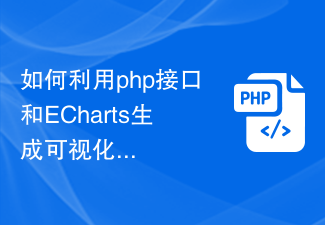 如何利用php接口和ECharts生成可视化的统计图表Dec 18, 2023 am 11:39 AM
如何利用php接口和ECharts生成可视化的统计图表Dec 18, 2023 am 11:39 AM在今天数据可视化变得越来越重要的背景下,许多开发者都希望能够利用各种工具,快速生成各种图表与报表,以便能够更好的展示数据,帮助决策者快速做出判断。而在此背景下,利用Php接口和ECharts库可以帮助许多开发者快速生成可视化的统计图表。本文将详细介绍如何利用Php接口和ECharts库生成可视化的统计图表。在具体实现时,我们将使用MySQL
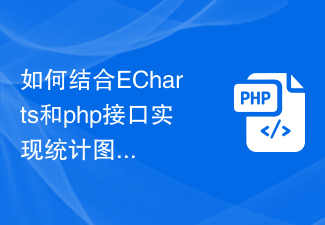 如何结合ECharts和php接口实现统计图的动态更新Dec 17, 2023 pm 03:47 PM
如何结合ECharts和php接口实现统计图的动态更新Dec 17, 2023 pm 03:47 PM如何结合ECharts和PHP接口实现统计图的动态更新引言:数据可视化在现代应用程序中起着至关重要的作用。ECharts是一个优秀的JavaScript图表库,可以帮助我们轻松创建各种类型的统计图表。而PHP则是一种广泛应用于服务器端开发的脚本语言。通过结合ECharts和PHP接口,我们可以实现统计图的动态更新,使图表能够根据实时数据的变化进行自动更新。本
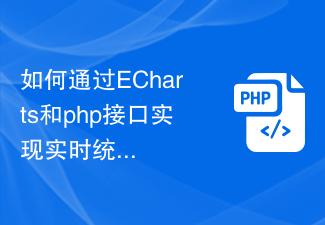 如何通过ECharts和php接口实现实时统计图的展示Dec 17, 2023 pm 04:35 PM
如何通过ECharts和php接口实现实时统计图的展示Dec 17, 2023 pm 04:35 PM如何通过ECharts和PHP接口实现实时统计图的展示随着互联网和大数据技术的快速发展,数据可视化成为了重要的一环。而ECharts作为一款优秀的开源JavaScript数据可视化库,能够帮助我们简单、高效地实现各种统计图的展示。本文将介绍如何通过ECharts和PHP接口实现实时统计图的展示,并提供相关代码示例。一、前期准备在开始之前,我们需要做一些准备工
 深入理解PHP接口的定义与使用方法Mar 24, 2024 am 08:45 AM
深入理解PHP接口的定义与使用方法Mar 24, 2024 am 08:45 AM深入理解PHP接口的定义与使用方法PHP是一种强大的服务器端脚本语言,广泛应用于Web开发领域。在PHP中,接口(interface)是一种重要的概念,它可以用来定义一组方法的规范,而不关心方法的具体实现。本文将深入探讨PHP接口的定义和使用方法,并提供具体的代码示例。1.什么是接口?在面向对象编程中,接口是一种抽象的概念,它定义了一组方法的规范,但没有具
 如何通过ECharts和php接口实现统计图的数据验证和校验Dec 18, 2023 pm 02:13 PM
如何通过ECharts和php接口实现统计图的数据验证和校验Dec 18, 2023 pm 02:13 PM如何通过ECharts和PHP接口实现统计图的数据验证和校验随着数据可视化的需求增加,ECharts成为了一个非常流行的数据可视化工具。而PHP作为一种常见的后端脚本语言,也广泛应用于Web开发中。本文将介绍如何通过ECharts和PHP接口实现统计图的数据验证和校验,并提供具体的代码示例。首先,我们需要了解ECharts。ECharts是一个由百度开发的开
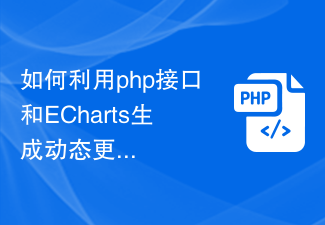 如何利用php接口和ECharts生成动态更新的实时统计图Dec 17, 2023 am 08:50 AM
如何利用php接口和ECharts生成动态更新的实时统计图Dec 17, 2023 am 08:50 AM如何利用php接口和ECharts生成动态更新的实时统计图,需要具体代码示例随着技术的不断发展,数据分析和可视化已经成为现代企业和机构必不可少的工具之一。ECharts作为一款流行的JavaScript数据可视化库,已经成为数据可视化的首选工具之一。而利用php接口与ECharts的结合,则可以实现更加灵活和动态的数据可视化效果。本文将介绍如何利用php接口
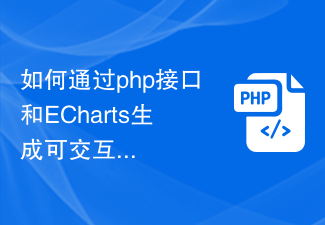 如何通过php接口和ECharts生成可交互的统计图表Dec 18, 2023 pm 01:07 PM
如何通过php接口和ECharts生成可交互的统计图表Dec 18, 2023 pm 01:07 PM在现代化的应用程序中,数据的可视化变得越来越流行。统计图表是一种很好的数据可视化方式,可以轻松地帮助用户了解数据的趋势。ECharts是一个强大的前端图表框架,它提供了丰富的图表类型和交互式功能。Php是一种非常流行的后端语言,可以轻松地生成动态内容和接口。在本文中,我们将介绍如何使用php接口和ECharts生成可交互的统计图表,并提供具体的代码示例。一、
 如何利用 PHP 接口实现企业微信机器人功能?Sep 12, 2023 pm 02:16 PM
如何利用 PHP 接口实现企业微信机器人功能?Sep 12, 2023 pm 02:16 PM如何利用PHP接口实现企业微信机器人功能?随着互联网的快速发展,企业在日常的运营中越来越重视自动化和智能化的工具。而企业微信机器人作为一种智能化工具,在企业内部的沟通和协作中发挥了重要的作用。本文将介绍如何利用PHP接口来实现企业微信机器人的功能。什么是企业微信机器人?企业微信机器人是企业微信中的一种应用程序,通过提供API接口,实现与企业微信的交互


Hot AI Tools

Undresser.AI Undress
AI-powered app for creating realistic nude photos

AI Clothes Remover
Online AI tool for removing clothes from photos.

Undress AI Tool
Undress images for free

Clothoff.io
AI clothes remover

AI Hentai Generator
Generate AI Hentai for free.

Hot Article

Hot Tools

Dreamweaver CS6
Visual web development tools

WebStorm Mac version
Useful JavaScript development tools

Notepad++7.3.1
Easy-to-use and free code editor

MinGW - Minimalist GNU for Windows
This project is in the process of being migrated to osdn.net/projects/mingw, you can continue to follow us there. MinGW: A native Windows port of the GNU Compiler Collection (GCC), freely distributable import libraries and header files for building native Windows applications; includes extensions to the MSVC runtime to support C99 functionality. All MinGW software can run on 64-bit Windows platforms.

Atom editor mac version download
The most popular open source editor






